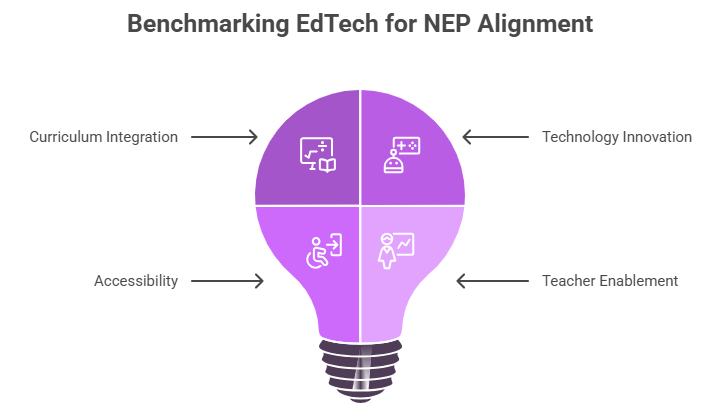India’s National Education Policy (NEP) 2020 has redefined the country’s education landscape, placing technology, flexibility, and experiential learning at the center of classroom transformation. This has created a new opportunity for EdTech providers: to align digital learning products with NEP’s vision of outcome-based, inclusive, and adaptive education.
As institutions move toward competency-based frameworks, the need for policy-aligned digital learning platforms has never been greater. However, the market is saturated with solutions that promise innovation but lack alignment with NEP priorities such as multilingual learning, digital accessibility, and teacher enablement.
In this evolving ecosystem, Product Benchmarking serves as a crucial differentiator. By analyzing the features, engagement models, and pricing structures of leading digital learning platforms, EdTech firms can uncover how to design offerings that are both NEP-compliant and learner-centric.
Benchmarking the New-Age Classroom: Aligning Offerings With NEP Priorities
The National Education Policy has shifted India’s education system from rote learning toward conceptual understanding, inclusivity, and digital-first pedagogy. This evolution demands that EdTech providers redesign their products around measurable learning outcomes, localized content, and adaptive technology. To stay relevant, companies must benchmark their offerings against the evolving standards of NEP-compliant classrooms.

- Curriculum Integration and Policy Alignment: EdTech products are now expected to align content with competency-based learning goals defined by NEP. Benchmarking helps assess how well digital platforms embed experiential learning, multilingual education, and cross-disciplinary content compared to industry leaders.
- Technology and Pedagogical Innovation: With blended learning becoming the norm, product benchmarking reveals how top players integrate AI-driven personalization, adaptive assessments, and gamification to enhance engagement. This allows firms to identify gaps in their digital architecture and introduce more intuitive learning experiences.
- Accessibility and Affordability: NEP emphasizes equitable access to technology for all learners, including those in rural or low-bandwidth regions. Benchmarking across pricing models, offline compatibility, and language support helps EdTech providers design inclusive products that serve diverse learner segments.
- Teacher Enablement and Analytics: Educators remain central to NEP’s success. Benchmarking tools can compare platforms on the depth of teacher dashboards, real-time feedback loops, and performance analytics, empowering instructors to guide students more effectively.
Through this lens, benchmarking transforms into a strategic instrument for EdTech companies to ensure their solutions actively drive NEP implementation rather than merely comply with policy requirements.
Nexdigm’s Digital Learning Product Benchmarking Framework
Nexdigm’s Digital Learning Product Benchmarking Framework enables EdTech companies to systematically evaluate their products against market leaders and NEP-aligned innovation benchmarks. It focuses on identifying the functional, pedagogical, and technological elements that drive success in policy-driven classrooms, helping firms enhance both impact and adoption.
- Feature and Policy Alignment Assessment: Nexdigm benchmarks product functionalities against NEP’s key objectives. This analysis reveals how effectively each feature contributes to curriculum integration, personalized learning, and student engagement.
- Engagement and Learning Outcome Metrics: The framework measures indicators such as learner interaction time, content completion, assessment adaptability, and engagement rates across digital platforms. These insights help EdTech providers refine learning design, gamification levels, and content interactivity to strengthen outcome-based delivery.
- Pricing and Accessibility Indexing: Nexdigm evaluates the affordability and accessibility of digital learning tools through pricing benchmarks, multilingual adaptability, and mobile-friendly design. The outcome helps EdTech companies develop inclusive pricing strategies and region-specific deployment models that support NEP’s vision of equitable learning access.
- Technology and Scalability Evaluation: From cloud infrastructure and AI personalization to teacher analytics dashboards, the framework assesses the scalability, integration readiness, and data security of EdTech products. This ensures that offerings remain technologically resilient and institution-ready for large-scale adoption.
- Strategic Roadmap and Recommendations: All insights are synthesized into an actionable Product Benchmarking Intelligence Report. Nexdigm provides tailored recommendations for feature optimization, pricing recalibration, and go-to-market realignment, ensuring each client’s EdTech portfolio is both NEP-aligned and competitively positioned.
Nexdigm’s Product Benchmarking Intelligence helps you navigate this transformation with data-driven precision. By combining policy insights, competitor analytics, and product performance benchmarks, we empower EdTech firms to create future-ready digital learning ecosystems that truly deliver on NEP’s vision of accessible, adaptive, and outcome-oriented education.
To take the next step, simply visit our Request a Consultation page and share your requirements with us.
Harsh Mittal
+91-8422857704

